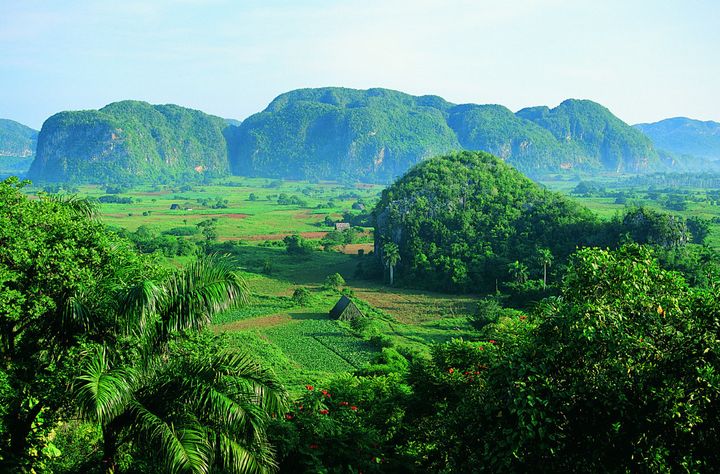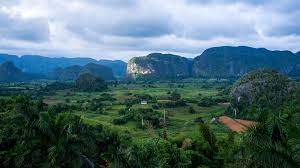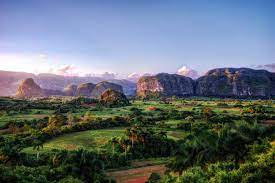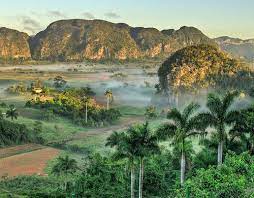NATURAL BEAUTIES OF CUBA: THE VIÑALES VALLEY. VIDEOS / PHOTOS
Viñales Valley (Spanish: Valle de Viñales) is a “karstic” (produced by the erosive or solvent action of water) depression in Cuba. The valley has an area of 132 km2 (51 sq mi) and is located in the Sierra de Los Órganos mountains (part of Guaniguanico range), just north of Viñales in the Pinar del Río Province. In 1999, the valley was inscribed on the UNESCO World Heritage List as a cultural landscape because of its use of traditional tobacco-growing techniques.
Tobacco and other crops are cultivated on the bottom of the valley, mostly by traditional agriculture techniques that have been in use for several centuries. These techniques allegedly make for higher-quality tobacco than if mechanical methods are used. The valley is dotted with small farms and villages which have been occupied since the time of the ‘conquistadores’, maintaining some vernacular colonial-era architecture. The culture of the valley was likewise influenced by a mixture of cultures: indigenous peoples, African slaves, and the Spanish colonizers.
Many caves dot the surrounding hill faces, including Cueva del Indio and Cueva de José Miguel. The conspicuous limestone mounds rising like islands from the bottom of the valley are called mogotes. They can be up to 300m tall.
Viñales is a major tourist destination offering mainly hiking and rock climbing. The local climbing scene has started to take off in the last few years with many new routes being discovered resulting in an increase in local tourism.
GEOGRAPHY
The extraordinary geomorphological formations known as mogotes, which are found nowhere else in Cuba, have sometimes not only attained the dimensions of mountains but have also taken on a variety of unusual shapes. The only comparable geological structures in the world are those to be found in Malacca, on the Malay peninsula, and in certain regions of China.
In the valley, there are other elevations, such as Alturas de Pizarras, which are formed from a variety of rocks, the oldest existing throughout the country and also in the Caribbean area.
CONSERVATION
Many endemic plants and animals are specific to this valley. Flora found in the region include Pachira emarginata [sv] (syn. Bombax emarginatum), mountain palm (Gaussia princeps), Ekmanianthe actinophylla, and Microcycas calocoma. Fauna includes bee hummingbird (Mellisuga helenae, zunzún), Cuban trogon (Priotelus temnurus), Cuban tody (Todus multicolor), Cuban solitaire (Myadestes elisabeth) and Cuban grassquit (Tiaris canorus).
MURAL DE PREHISTORY
In the valley of Dos Hermanas, we can find the Mural of Prehistory, which is painted on a stone of one of the elevations. This mural shows the evolution of life in a natural sense of Cuba.
The Mural of Prehistory is located in the mogote called Pita. It can be found on a perpendicular slope. The rock was washed and drains were also made in it to avoid erosion in the future due to the rain. It is 120 meters high and 160 meters in length. The artist was Leovigildo González Morillo, who was Director of Cartography of the Academy of Sciences of Cuba.
In it are represented Guanahatabeyes Indians, species of mammals, gigantic animals, as well as some mollusks.
In the Mural can be seen in 12 pieces the evolutionary process of men and animals in the Sierra de Los Organs, in its different stages.
BELLEZAS NATURALES DE CUBA: EL VALLE DE VIÑALES. VIDEOS / FOTOS
El Valle de Viñales es una depresión “kárstica” (producido por la acción erosiva o disolvente del agua) en Cuba. El valle tiene un área de 132 km2 (51 millas cuadradas) y está ubicado en la Sierra de Los Órganos (parte de la cordillera Guaniguanico), justo al norte de Viñales en la provincia de Pinar del Río. En 1999, el valle fue inscrito en la Lista del Patrimonio Mundial de la UNESCO como paisaje cultural debido a su uso de técnicas tradicionales de cultivo de tabaco.
El tabaco y otros cultivos se cultivan en el fondo del valle, principalmente mediante técnicas agrícolas tradicionales que se han utilizado durante varios siglos. Estas técnicas supuestamente producen un tabaco de mayor calidad que si se utilizan métodos mecánicos. El valle está salpicado de pequeñas granjas y pueblos que han sido ocupados desde la época de los ‘conquistadores’, manteniendo una arquitectura vernácula de la época colonial. La cultura del valle también fue influenciada por una mezcla de culturas: pueblos indígenas, esclavos africanos y colonizadores españoles.
 VIDEOS – VALLEY DE VIÑALES, CUBA
VIDEOS – VALLEY DE VIÑALES, CUBA
Muchas cuevas salpican las caras de las colinas circundantes, incluidas la Cueva del Indio y la Cueva de José Miguel. Los llamativos montículos de piedra caliza que se elevan como islas desde el fondo del valle se llaman mogotes. Pueden tener hasta 300 m de altura.
Viñales es un importante destino turístico que ofrece principalmente senderismo y escalada en roca. La escena de la escalada local ha comenzado a despegar en los últimos años con el descubrimiento de muchas rutas nuevas que han dado lugar a un aumento del turismo local.
GEOGRAFIA
Las extraordinarias formaciones geomorfológicas conocidas como mogotes, que no se encuentran en ningún otro lugar de Cuba, a veces no solo han alcanzado las dimensiones de montañas, sino que también han adquirido una variedad de formas inusuales. Las únicas estructuras geológicas comparables en el mundo son las que se encuentran en Malaca, en la península de Malaca y en ciertas regiones de China.
En el valle existen otras elevaciones, como Alturas de Pizarras, que se forman a partir de una variedad de rocas, las más antiguas existentes en todo el país y también en la zona del Caribe.
CONSERVACIÓN
Muchas plantas y animales endémicos son específicos de este valle. La flora que se encuentra en la región incluye Pachira emarginata [sv] (sin. Bombax emarginatum), palma de montaña (Gaussia princeps), Ekmanianthe actinophylla y Microcycas calocoma. La fauna incluye el colibrí abeja (Mellisuga helenae, zunzún), el trogón cubano (Priotelus temnurus), el tody cubano (Todus multicolor), el solitario cubano (Myadestes elisabeth) y el pasto cubano (Tiaris canorus).
MURAL DE PREHISTORIA
En el valle de Dos Hermanas, podemos encontrar el Mural de la Prehistoria, que está pintado sobre una piedra de una de las elevaciones. Este mural muestra la evolución de la vida en un sentido natural de Cuba.
El Mural de la Prehistoria se encuentra en el mogote llamado Pita. Se puede encontrar en una pendiente perpendicular. La roca fue lavada y también se hicieron desagües en ella para evitar la erosión en el futuro por la lluvia. Tiene 120 metros de altura y 160 metros de longitud. El artista fue Leovigildo González Morillo, quien fue Director de Cartografía de la Academia de Ciencias de Cuba.
En él están representados indios Guanahatabeyes, especies de mamíferos, animales gigantes, así como algunos moluscos.
En el Mural se puede apreciar en 12 piezas el proceso evolutivo de hombres y animales en la Sierra de Los Órganos, en sus diferentes etapas.
Agencies/ Wiki/ Internet Photos/ YouTube/ Arnoldo Varona/ www.TheCubanHistory.com
THE CUBAN HISTORY, HOLLYWOOD.



 NATURAL Beauties of Cuba: The VIÑALES Valley. VIDEOS / PHOTOS * BELLEZAS Naturales de Cuba: El Valle de VIÑALES. Videos / Photos.
NATURAL Beauties of Cuba: The VIÑALES Valley. VIDEOS / PHOTOS * BELLEZAS Naturales de Cuba: El Valle de VIÑALES. Videos / Photos.





